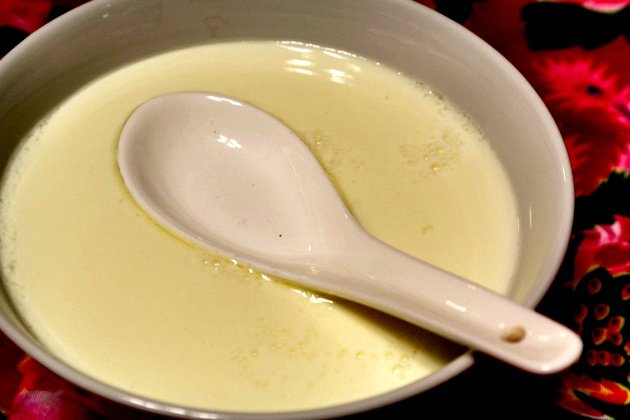
Making the “mysterious” Ginger Milk Pudding
By The Feiloh - Wednesday, Feb 27, 2013
Fact is…there is no mystery to making the Cantonese ginger milk pudding dessert. Its colourful moniker in Chinese is 姜汁撞奶 “ginger juice colliding with milk” and its preparation has stumped many a fan as the technique seems to be shrouded in myth.
There is nothing to it: all it takes are to stir one teaspoon of sugar and one tablespoon of fresh ginger juice into scaled milk at less than 80 degrees Celsius and allowing the mixture to cool and curdle.
Curdling milk is not the only property of ginger. Under Traditional Chinese Medicine, ginger is thought to be “warming”, that is, it can dispel chills and thus treat coughs and colds. Ginger is also used to treat tummy problems such as diarrhoea and bloating, as well as cure nausea and headaches. It is thought to promote circulation and can even neutralise poisons.
This popular dessert in Southern China is thought to have originated from the Panyu district of Guangdong Province, probably by someone who wanted to counter the “dampness” or cooling effects of milk by mixing it with ginger.
Before I knew about the warming effects of ginger, I asked for the pudding when I was in Hong Kong in the summer. The dessert or “tong-sui” shopkeeper gave me a strange look and told me ginger milk pudding is usually only made in the colder months – doh!
Despite its seasonal availability abroad, it is actually quite easy to make the dessert at home, anytime you wish.
It is believed that enzymes in mature ginger root will cause proteins in warm milk to curdle or clump together.
From my biochemistry background, I knew that enzymes are destroyed (denatured) by heat; as such, the milk shouldn’t be boiling hot. Also, you can’t use a high-speed juicer to process the ginger as any foaming will also inactivate its enzymes.
But what is puzzling is that the temperature is really quite warm for biological enzymes to work. The ideal temperature for this reaction is between 65 to 80 degrees Celsius.
Given these requirements, the ideal way of obtaining ginger juice is by using a low-speed juicer and to monitor the temperature of the milk with a thermometer, the type used by coffee baristas to steam milk.
If you don’t have these two pieces of ingredients, don’t despair: just follow the simple recipe below to prepare the pudding the traditional way.

Ingredients:
100-150g fresh mature ginger
500ml of regular, fresh full-cream milk
Fine white sugar to taste
Method:
1) Keep the ginger in the fridge until you are ready to use. Grate the ginger finely (watch your fingers) and squeeze through a cloth filter to obtain the juice. Store the juice immediately in the fridge.
2) Add two to four teaspoons of sugar (depending on your taste) to the milk and heat in a pot (I like using an induction cooker). Stir often until the milk just begins to simmer. If you have a thermometer, take the milk off the heat before the temperature reaches 80 degrees C. If a layer of protein forms on the surface, chuck it and start again with a fresh batch of milk.
3) If you don’t have a thermometer, remove the milk from heat once the milk just starts to boil and pour it back and forth between large mugs for about 10 times, just like making teh tarik. This is to cool the milk to the ideal range of 65 to 80 degrees Celsius.
4) Stir in at least two tablespoons of the ginger juice. You may add another one tablespoonful of the ginger juice if you wish, if you like it more spicy.
5) Pour half a cup (125ml) each into bowls or ramekins and allow the pudding to cool and form, in about five to 10 minutes.
6) Serve warm immediately or chill in the fridge. Impress your friends and family at your next dinner party.


